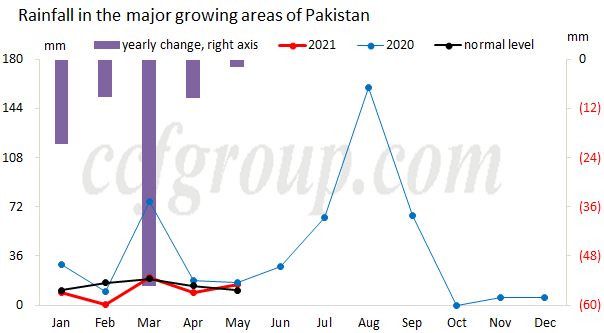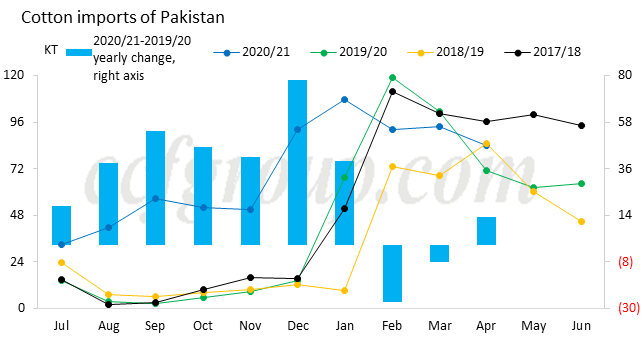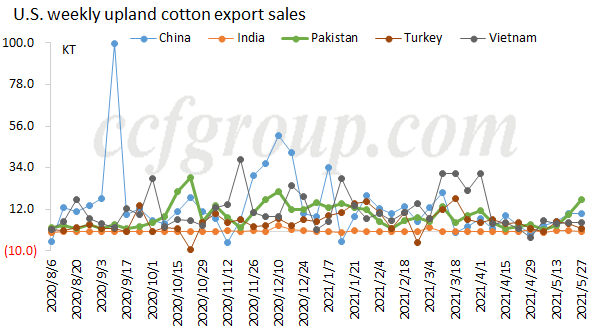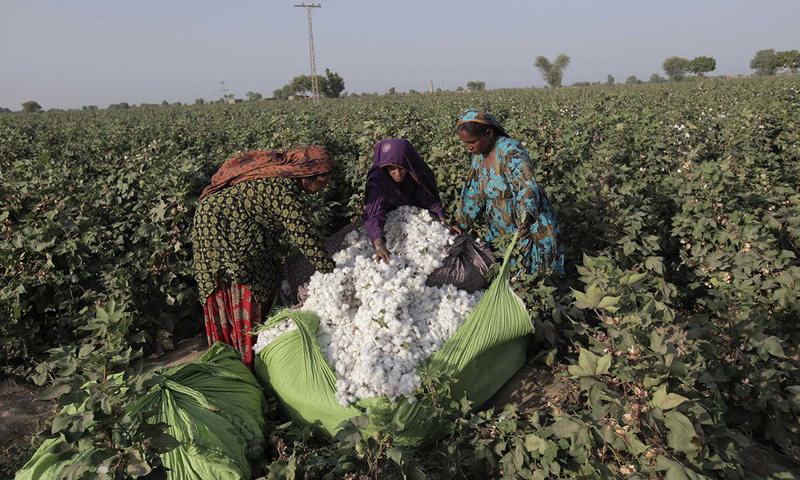In May, when ICE cotton futures and Cotlook A index stepped lower obviously, Pakistani spot cotton rate rose by 8.8%. Currently, the sowing progress of new cotton crops in Pakistan remains slow, while demand for imported cotton is active. Pakistani cotton prices are predicted to be easy to rise but hard to decline.
| 30-Apr | 28-May | Change | |
| Cotlook A (cent/lb) | 91.9 | 89.7 | -2.39% |
| ICE Jul contract (cent/lb) | 88.34 | 82.12 | -7.04% |
| Pakistani cotton, Karachi spot rate (Rs/maund) | 11300 | 12300 | 8.85% |
1. Sowing is dragged down by weather disruption and lower benefits
According to data tracked by CCFGroup, as of the end of May, the cotton planting areas in Pakistan reached 1.72 million hectares, a year-on-year decrease of 17.3%, about 76.5% of the target areas. The planting areas in Punjab were 1.26 million hectares, down 14% year on year, about 78.3% of the target areas, and that in Sindh were 0.46 million hectares, down 25.2% year on year, about 71.9% of the target areas. The planting progress is obviously slow.
| Pakistani cotton planting areas target and actual progress (million hectare) | |||||||
| 2021/22 | 2020/21 | Target complete | |||||
| Punjab | Sindh | Punjab | Sindh | Punjab | Sindh | Total | |
| Target | 1.61 | 0.64 | 1.6 | 0.64 | |||
| Complete | 1.55 | 0.62 | |||||
| 1-May | 0.24 | 0.27 | 14.80% | ||||
| 7-May | 0.24 | 0.3 | 37.30% | 21.20% | |||
| 17-May | 0.35 | 0.34 | |||||
| 28-May | 0.46 | 0.62 | 71.90% | ||||
| 31-May | 1.26 | 1.47 | 78.30% | 76.50% | |||
On the one hand, it is affected by the lower rainfall and high temperatures in the main cotton producing areas of Pakistan this year. From January to May this year, the cumulative rainfall in the main cotton producing regions of Pakistan (Punjab + Sindh) decreased by 64% compared with the same period last year, and was down by 24% from the normal level in previous years. The cumulative rainfall in Punjab has dropped by 64% compared with the same period last year, and was down 20% from the normal level in previous years. The cumulative rainfall in Sindh has dropped by 60% year on year and it has dropped by 64% from the normal level in previous years. Punjab Agriculture Minister said that Punjab faced 22% of water shortage and Sindh faced 17% of the shortage. In the meantime, the temperature was relatively high.

On the other hand, since last year, the price of international corn has increased by more than 50% while the price of cotton has increased by only about 20%. The income of planting corn is higher than that of cotton. Besides, the yield of corn is higher and the requirement for water resources is relatively lower, so some growers turn to plant corn. It is reported that the cotton sowing areas in the two main cotton growing areas Shujaabad and Jalalpur Peer Wala has decreased by more than 25-30% this In addition, the germination is low, which has low effective resistance to drought and high temperature, and the limited effectiveness of existing insecticides against whiteflies and other pests also restrain cotton production.
2. Strong imported cotton demand
Due to the sharp decline in Pakistani cotton production and the strong demand for cotton, the cotton imports of Pakistan have been relatively high this season. Until the outbreak of pandemic in India spreads to Pakistan, the lock-down measures during the Eid holiday lead to the obvious fall of cotton imports.

However, after the end of Eid holiday, Pakistan's cotton imports showed signs of increasing again. According to the weekly USDA's cotton export data, as of the week of May 27, 2020/21 US upland cotton export sales were 41kt, and 17kt from Pakistan and 10kt from China. This has been the two consecutive weeks for Pakistan to see the high export sales data. It is understood that large spinning mills are the major importers in Pakistan, and small spinning mills mainly procure local cotton restrained by capital.

In summary, new cotton crop planting progress is slow currently affected by the dry weather and other crops, while demand for imported cotton is strong. The local cotton supply shortage may continue, and cotton prices are likely to be easy to rise but hard to decline.
Πηγή: ccfgroup.com

